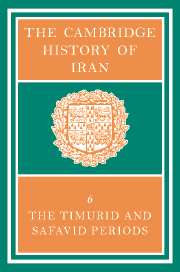Book contents
- Frontmatter
- 1 THE JALAYIRIDS, MUZAFFARIDS AND SARBADĀRS
- 2 TĪMŪR IN IRAN
- 3 THE SUCCESSORS OF TĪMŪR
- 4 THE TÜRKMEN DYNASTIES
- 5 THE SAFAVID PERIOD
- 6 THE SAFAVID ADMINISTRATIVE SYSTEM
- 7 EUROPEAN CONTACTS WITH PERSIA, 1350–1736
- 8 TRADE FROM THE MID-14TH CENTURY TO THE END OF THE SAFAVID PERIOD
- 9 SOCIAL AND INTERNAL ECONOMIC AFFAIRS
- 10 THE EXACT SCIENCES IN TIMURID IRAN
- 11 PERSIAN SCIENCE IN SAFAVID TIMES
- 12 RELIGION IN THE TIMURID AND SAFAVID PERIODS
- 13 SPIRITUAL MOVEMENTS, PHILOSOPHY AND THEOLOGY IN THE SAFAVID PERIOD
- 14 CARPETS AND TEXTILES
- 15 (a) TIMURID ARCHITECTURE
- (b) SAFAVID ARCHITECTURE
- 16 (a) THE PICTORIAL ARTS IN THE TIMURID PERIOD
- (b) THE ARTS IN THE SAFAVID PERIOD
- 17 (a) PERSIAN LITERATURE IN THE TIMURID AND TÜRKMEN PERIODS (782–907/1380–1501)
- (b) HĀFIZ AND HIS CONTEMPORARIES
- (c) PERSIAN LITERATURE IN THE SAFAVID PERIOD
- 18 PERSIAN POETRY IN THE TIMURID AND SAFAVID PERIODS
- Bibliographies
- Plate section
- Plate section
- Plate section
- Maps
- References
6 - THE SAFAVID ADMINISTRATIVE SYSTEM
Published online by Cambridge University Press: 28 March 2008
- Frontmatter
- 1 THE JALAYIRIDS, MUZAFFARIDS AND SARBADĀRS
- 2 TĪMŪR IN IRAN
- 3 THE SUCCESSORS OF TĪMŪR
- 4 THE TÜRKMEN DYNASTIES
- 5 THE SAFAVID PERIOD
- 6 THE SAFAVID ADMINISTRATIVE SYSTEM
- 7 EUROPEAN CONTACTS WITH PERSIA, 1350–1736
- 8 TRADE FROM THE MID-14TH CENTURY TO THE END OF THE SAFAVID PERIOD
- 9 SOCIAL AND INTERNAL ECONOMIC AFFAIRS
- 10 THE EXACT SCIENCES IN TIMURID IRAN
- 11 PERSIAN SCIENCE IN SAFAVID TIMES
- 12 RELIGION IN THE TIMURID AND SAFAVID PERIODS
- 13 SPIRITUAL MOVEMENTS, PHILOSOPHY AND THEOLOGY IN THE SAFAVID PERIOD
- 14 CARPETS AND TEXTILES
- 15 (a) TIMURID ARCHITECTURE
- (b) SAFAVID ARCHITECTURE
- 16 (a) THE PICTORIAL ARTS IN THE TIMURID PERIOD
- (b) THE ARTS IN THE SAFAVID PERIOD
- 17 (a) PERSIAN LITERATURE IN THE TIMURID AND TÜRKMEN PERIODS (782–907/1380–1501)
- (b) HĀFIZ AND HIS CONTEMPORARIES
- (c) PERSIAN LITERATURE IN THE SAFAVID PERIOD
- 18 PERSIAN POETRY IN THE TIMURID AND SAFAVID PERIODS
- Bibliographies
- Plate section
- Plate section
- Plate section
- Maps
- References
Summary
Before the principal phases in the development of the Safavid administrative system are discussed in detail, a brief outline of the Safavid administrative and social structure may be helpful. At the apex of this structure was the shah. Never was the Divine Right of Kings more fully developed than by the Safavid shahs. Shah Ismā'īl I, who established the Safavid dynasty in 907/1501–2, considered himself to be the living emanation of the godhead, the Shadow of God upon earth, and the representative of the Hidden Imām by virtue of direct descent from the Seventh Imām of the Twelver (Ithnā'ashariyya) Shī'a, Mūsā al-Kāzim. It is axiomatic that such a ruler would command instant and unquestioning obedience from his subjects. Since the ruler was directly appointed by God, men were required to obey his commands whether just or unjust. Since the ruler, as the representative of the Hidden Imām, was closer to the source of absolute truth than were other men, opposition to him was a sin. This led inevitably to an assumption of kingly infallibility. In other words, the Safavid shahs usurped the function which the Ithnā'asharī mujtahids had arrogated to themselves, namely, that of acting as the representative on earth of the Mahdī, the Ithnā'ashar' messiah. The net result of these various Safavid theories of kingship was absolutism. In practice, however, there were well defined limits to this absolutism, even when the shah was a strong and capable ruler. Chardin declares emphatically that outside court circles there was no arbitrary exercise of power by the shah, and both Chardin and Malcolm assert that the awe in which the shah was held by the court and the nobility was the primary reason for the relative security and freedom from oppression enjoyed by the lower classes.
- Type
- Chapter
- Information
- The Cambridge History of Iran , pp. 351 - 372Publisher: Cambridge University PressPrint publication year: 1986
References
- 5
- Cited by



